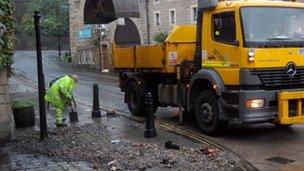West Yorkshire flood victims call for peat burning ban
- Published

The centre of Hebden Bridge in West Yorkshire was flooded twice during the summer
Residents of a town hit by flooding have launched a campaign to stop the burning of moorland peat bogs.
The centre of Hebden Bridge in West Yorkshire was flooded twice during the summer.
Campaigners claim that peat burning on the surrounding moors has increased the flood risk, as the peat acts as a sponge soaking up rain water.
Natural England has signed a agreement with a company to manage the Walshaw Moors, which allows limited burning.
The campaign has organised a protest walk from the town to Walshaw Moors.
One of the organisers, Dongria Kondh, said that managing water catchment on the moors would help reduce the impact of flooding in the area.
She said: "The management of the uplands is being used for grouse, rather than of the environmental services which the uplands can provide for the towns in the valleys bellow.
"One of the things that would make the flood risk in the town less acute would be a well managed upland catchment with spongy moss and blanket bogs to soak up all the water when we have those heavy rainfall events."
Natural England said that the 25-year deal with Walshaw Moor Estate Ltd to manage the moorland would mean "improved environmental protection for the Moors".
In statement Natural England said: "For the first time, burning activities on the Walshaw Estate will be subject to specific controls.
"Under the terms of the consent, burning will not be permitted in areas where heather amounts to less than 50% of the vegetation cover and will not be permitted in most of the areas defined as sensitive by the Heather and Grass Burning Code 2007.
"In the areas where it has been agreed that burning can take place, limits have been set regarding the length of the burning rotation."
- Published9 July 2012
- Published6 July 2012